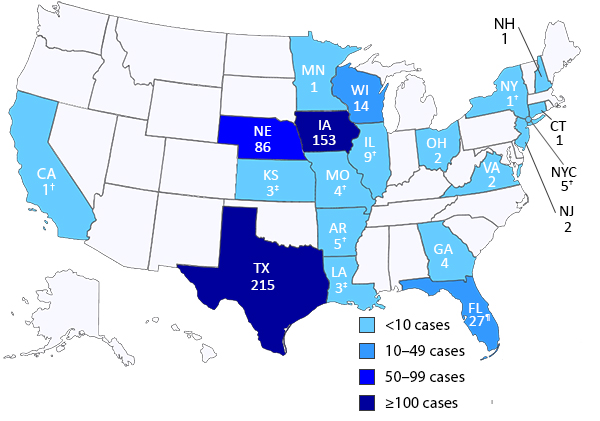CDC reports more Cyclospora cases, including California's first
The US Centers for Disease Control and Prevention (CDC) reported four more Cyclospora infections today in a multistate outbreak, raising the official case count to 539, but the total does not include 20 new cases reported by Texas yesterday, which would bring the tally to 559.
California has reported its first case, which raises the number of affected states to 19 (see CDC map below). That case was likely acquired out of state, the CDC said. The states with by far the most cases are Texas, 215 (by the CDC's count); Iowa, 153; and Nebraska, 86.
As yet it's not clear if all of the cases in all of the states are related to the ones in Iowa and Nebraska, the CDC said.
The most recent illness onset was Jul 28, but most cases were reported in the middle of June through early July. Of the 539 cases, 32 (6%) have required hospitalization.
Trace-back investigations have linked restaurant-related illness clusters in Iowa and Nebraska to a prepackaged salad mix from a Taylor Farms facility in Mexico. Yesterday the US Food and Drug Administration (FDA) said that Taylor Farms has voluntarily stopped shipping all of its leafy greens to the United States.
Aug 13 CDC outbreak update
Aug 12 Texas Department of State Health Services update
Aug 12 FDA notice

Report: Human MRSA strain came from cows
The emerging methicillin-resistant Staphylococcus aureus (MRSA) strain known as CC97 crossed from cattle to humans decades ago and became resistant to methicillin after this species jump, says a report today in mBio, the journal of the American Society for Microbiology (ASM).
The strain is spreading among humans, particularly in Europe, North and South America, Africa, and Asia, the authors say.
In their study, UK and Danish researchers sequenced genomes of 43 CC97 isolates from humans, cattle, and other animals and plotted the genetic relationships in a phylogenetic tree. The strains found in humans most resembled those found in cattle, the authors note.
Two distinct clades of CC97 affect humans and appear, the authors write, to have jumped to humans at two separate times. They determined through analyzing mutation rates that clade A crossed over to humans between 1894 and 1977 and clade B between 1938 and 1966.
The human strains of CC97 have acquired resistance to methicillin, unlike the strains in other species. The researchers attribute this to the bacteria's exposure to antibiotics used for treating human S aureus infections.
The authors say their findings "provide evidence that livestock represent a reservoir for the emergence of new human-pathogenic S aureus clones with the capacity for pandemic spread" and "have major public health implications highlighting the importance of surveillance for early identification of emergent clones and improved transmission control measures at the human-livestock interface."
Aug 13 mBio study
Aug 13 ASM press release
Study says pseudovirus-based assay may help identify H7N9
Chinese researchers have developed a safe pseudovirus-based test for H7N9 influenza that would not require a biosafety-level–3 lab, they reported yesterday in Emerging Infectious Diseases.
The team used a previously reported method that involves assembling the pseudovirus with membrane proteins of hemagglutinin (HA) and neuraminidase from H7N9 and capsid protein from HIV. They then used the pseudovirus assay to measure neutralizing antibodies in 14 convalescent sera samples that had known HA inhibition (HI) titers for H7N9.
They found that the pseudovirus-based assay significantly correlated with HI titer measured by conventional HI assay.
"This pseudovirus-based neutralization assay could be used as an alternative for safely conducting serologic studies in a rapid response in assessing the threat posed by subtype H7N9 virus," the authors concluded. They added that their assay was less sensitive than the conventional HI assay, "indicating that some false-negative results would be observed."
Aug 12 Emerg Infect Dis study










